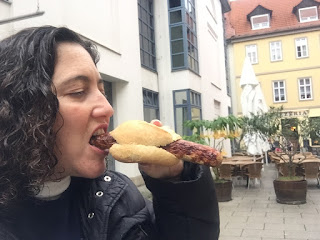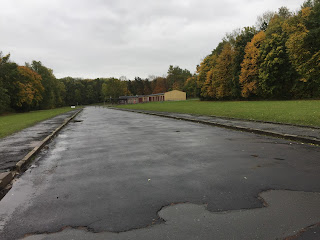As we make the over three hour bus journey to Buchenwald Concentration Camp, I am anxious, curious, hesitant, and fearful. One of my fellow travelers went through the Nazi regime as a child and has told us stories about neighbors being shot, mass executions, and his family being shot at by Nazi police. He called it being refugees in Germany as they travelled around to keep alive. It’s hard to emotionally prepare myself for the experience that lies ahead of me this afternoon.
We stopped at Germany’s cultural capital, Weimar. Weimar has been home to many famous people, most of whom we have already “met”: Bach lived here as court organist for 9 years; Cranach lived here the last year of his life before he died and left an altar in the church chapel; yes, even Luther was here in 1518, as he was gaining fame because of his 95 thesis. This is where he preached.


But the city belongs to Goethe (pronounced here as Guder). He was born and died here and wrote several important works including Faust. This is the house where he lived.

He headed up the National Theater for 20 years here where his statue remains today.

This city seemed different than others. It’s hard to explain. We later found out this is where the Nazi’s had their stronghold and many rallies in this same plaza. The third Reich in some ways was born here. It was an eerie feeling, especially knowing what lay ahead.
We had lunch here, a typical German bratwurst, before we headed off 8 kilometers to Buchenwald.


We began watching a 30 minute video about how the concentration camp began and what happened while it was active. Then we toured the grounds, although there was not much left to see of the original facilities.

I found it appropriate that is what cold and rainy the entire time we were there. The camp started July 13, 1937 built by the prisoners themselves from the nearby stone quarry. It was a labor camp, not an extermination camp like Dachau. Nevertheless, 56,000 died in the next 8 years it was open, some through the harsh conditions, disease, starvation, and murder.
Their were three tiers of prisoners indicated by different color triangles attached to their clothing.

The top tier were for those people of the Arian race whether political prisoners, criminals, the homeless, ministers, those who were homosexual, or anti-social or anti-government prisoners. Because they were in the top tier, their living conditions were better, food rations better, and assigned work easier. They could receive care packages from family members and even send letters to family after first being censored by the SS.
The middle tier of prisoners were those from other countries. Over 35 nationalities were represented at Buchenwald. Their conditions, too, were hard but not usually unbearable.
Then there was the bottom tier. They had their own section of the camp outlined in electrified barbed wire.

This is a model of it.

These were the Jews and Gypsies, as well as those considered racially inferior. They had the harshest living conditions receiving half of the food rations of the top tier, sleeping 12 to a bed if they could get a bed at all, and having the hardest work in the stone quarry where many died.
There were many types of punishments if you didn’t follow the rules including a prison designed for one but often held three, torture, and execution. The prison inside the camp contained these cells
Some people, like pastor Paul Schneider are memorialized in these cells.

The cells were at the front of the camp, so all could see. They were attached to the gate prisoners marched toward down this road.

And then through the gates.


The first thing they did was go to the disinfecting area (the smaller building on the right) where prisoners were shaved and immersed in “disinfectant”.

Every morning and evening they would stand in this gravel area for roll call where their assigned numbers were called.

The crematorium was built in 1940 because it became impractical to keep taking all the bodies down to the nearby city.

They could burn three bodies at a time in each oven.
Plus when you owned the crematorium, you wrote the death certificates and could easily lie about the cause of death. Before they cremated the bodies, they would take out any valuables, like gold teeth.

At the Gate the words were inscribed, “To each his own,” or in other words, “You get what you deserve.” Buchenwald was the “main” camp where training of SS soldiers took place, SS families live (and there was even a casino and a zoo for the entertainment of old and young alike), and where thousands of prisoners were registered before being shipped to one of 136 sub camps under Buchenwald. In all, over 250,000 people were registered at the camp. 56,000 people died there. 21,000 were alive when it was liberated. The rest were transferred to other camps, usually extermination camps. This happened to Dietrich Bonhoeffer, whom we will learn about later in the trip, who was transferred to Flossenburg camp before being executed April 9, 1945.

On April 11, 1945, American troops reached the camp. Most SS soldiers had fled before the troops arrived which is why the inmates were able to take control of the camp from the inside when the American troops came from the outside. They were shocked at what they saw. No one on the outside knew exactly what was going on in the inside. The people of Weimar, just about 5 miles away, were forced to walk through the camp to see the conditions. They couldn’t believe it either. They just thought it was a prison camp for bad people. 21,000 people walked out alive, yet forever scarred. This is the memorial to them inside the camp.

Afterward, the Soviet Union used the camp for Nazi’s so thousands more died after 1945 as this continued to be used as a prisoner camp that brought death.
The whole thing was a sobering experience. We prayed and sang, “A Mighty Fortress Is our God” before we went in. We sang and prayed again after our visit. May we never forget the atrocities human beings can do to one another. May our resolve be strengthened never to let this happen again.



A sobering journey, indeed. We visited Dachau two summers ago on a bright sunny day, but the sadness seeped through the sunshine. Such cruelty and evil by our fellow humans is hard to understand. Praise God for people of conscience who fight against this kind of cruelty.
ReplyDelete